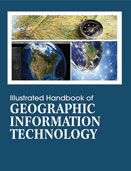Handbooks

Geographic information technology uses computer-based tools to analyze spatial information into a geographic information system (GIS). In a GIS, data of the real world are stored into a georeferenced database, which can be displayed via maps. There is a dynamic link between the displayed maps and the stored georeferenced data, that is, a change on the maps leads to a change in the database and vice versa. Use of GIS has seen unprecedented growth in the last ten years. With the powerful technology getting cheaper and system memories expanding, meaning that we can handle much bigger sets of data, some say that GIS is in a golden age. There are a number of applications that use geographic information technologies in numerous economical sectors, such as transportation, medicine, agriculture, mineral exploration, forestry, and governance. This book emphases on the use of GIS and the technology it has been allied to and other areas of geographic information technology.
Geographic information technology uses computer-based tools to analyze spatial information into a geographic information system (GIS). In a GIS, data of the real world are stored into a georeferenced database, which can be displayed via maps. There is a dynamic link between the displayed maps and the stored georeferenced data, that is, a change on the maps leads to a change in the database and vice versa. GIS is one of many information technologies that have transformed the ways geographers conduct research and contribute to society. In the past two decades, these information technologies have had tremendous effects on research techniques specific to geography, as well as on the general ways in which scientists and scholars communicate and collaborate.
Illustrated Handbook of Geographic Information Technology focuses on the use of GIS and the technology it has been linked to and describes how to implement a successful geographic information system. In the context of technological innovations, geographic information systems have served an important role as an integrating technology. Rather than being completely new, GIS have evolved by linking a number of discrete technologies into a whole that is greater than the sum of its parts. GIS have emerged as very powerful technologies because they allow geographers to integrate their data and methods in ways that support traditional forms of geographical analysis, such as map overlay analysis as well as new types of analysis and modeling that are beyond the capability of manual methods. With GIS it is possible to map, model, query, and analyze large quantities of data all held together within a single database.
The importance of GIS as an integrating technology is also evident in its pedigree. GIS are now used extensively in government, business, and research for a wide range of applications including environmental resource analysis, land use planning, locational analysis, tax appraisal, utility and infrastructure planning, real estate analysis, marketing and demographic analysis, habitat studies, and archaeological analysis. Illustrated Handbook of Geographic Information Technology presents comprehensive information on the concepts, theory, processes, and real world applications of geographical information systems (GIS). This illustrated Handbook is intended as a Textbook for students and researchers involved in the areas of Geography, Cartography, Photogrammetry, Remote Sensing, Surveying, Geodesy, Civil Engineering, Statistics, Computer Science, Operations Research, Artificial Intelligence, Demography, and many other branches of the social sciences, natural sciences, and engineering.